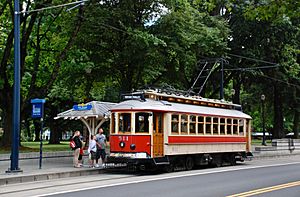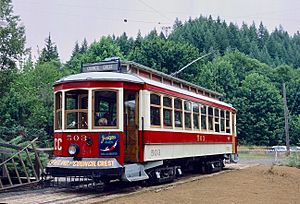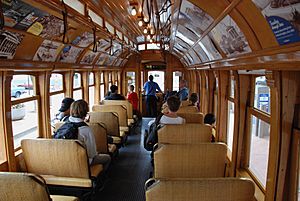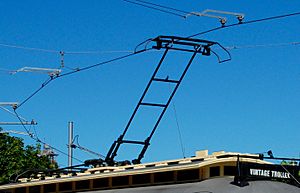Portland Vintage Trolley facts for kids
Quick facts for kids Portland Vintage Trolley |
|
|---|---|
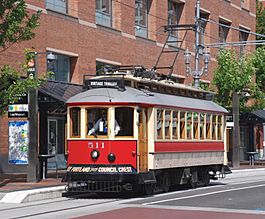
One of the replica Brill cars at the PSU Urban Center station in September 2009
|
|
| Overview | |
| Status | Ceased operation |
| Owner | TriMet and Vintage Trolley, Inc. |
| Locale | Portland, Oregon, U.S. |
| Service | |
| Type | Heritage streetcar |
| System | MAX Light Rail of TriMet (1991–2014); also Portland Streetcar (2001–2005) |
| Operator(s) | TriMet |
| Rolling stock | 4 Gomaco-built 1903 Brill replicas |
| History | |
| Opened | November 29, 1991 |
| Closed | July 6, 2014 |
| Technical | |
| Track gauge | 4 ft 8 1⁄2 in (1,435 mm) (standard gauge) |
| Electrification | Overhead lines, 750 V DC |
The Portland Vintage Trolley was a special streetcar service in Portland, Oregon. It ran from 1991 to 2014. These trolleys used parts of the city's MAX Light Rail tracks. For a short time, they also ran on the Portland Streetcar system. The service used special replica streetcars. These cars looked like the old "Council Crest" streetcars. The original "Council Crest" cars stopped running in Portland in 1950.
A non-profit group called Vintage Trolley Inc. helped manage the service. TriMet, Portland's public transportation agency, owned and operated the cars. For most of its time, the service ran on a 2.3-mile (3.7 km) section of the MAX Blue Line. This route went between Lloyd Center and downtown Portland. In 2009, the route changed. It then ran on a 1.5-mile (2.4 km) section of the MAX system. This new route was along the Portland Transit Mall in downtown. It went from Union Station to Portland State University (PSU).
The Vintage Trolley usually ran on most weekends or Sundays. This was from March through December each year. From 1994 to 1999, it even ran seven days a week. After 2011, the service ran much less often. It only operated on seven days each year until it stopped completely. A conductor would tell stories about historic places along the route. After May 1994, rides were free, but people could give donations.
The service was planned to end on December 22, 2013. This was because TriMet decided to sell two of the replica streetcars. These cars were sold to a group planning a streetcar line in St. Louis, Missouri. Two other cars had already been moved to the Willamette Shore Trolley fleet. However, the sale to St. Louis was delayed. So, TriMet added two more service dates: May 25 and July 6, 2014. The last day the Portland Vintage Trolley ran was July 6, 2014.
Contents
History of the Portland Vintage Trolley
How the Trolley Service Started
The Portland Vintage Trolley service began on November 29, 1991. It used a 2.3-mile (3.7 km) part of TriMet's first MAX line. This route went between Lloyd Center and the Galleria/SW 10th Avenue station downtown. It even crossed the Willamette River on the Steel Bridge.
The idea for vintage streetcars in Downtown Portland came up in the 1970s. People thought it would bring shoppers back to the city center. Shoppers were starting to prefer malls outside the city. A Portland businessman named Bill Naito was a big supporter of this idea. He later became the first president of Vintage Trolley, Inc.
The idea gained more support after 1978. That's when plans for Portland's light rail system were approved. This system became known as MAX Light Rail. Another reason for the trolleys was to protect historic areas downtown. The light rail line would pass through the Skidmore/Old Town and Yamhill Historic Districts. Running vintage streetcars during slower times was seen as a way to help these areas.
TriMet approved plans for the vintage trolley service in 1987. TriMet, the federal government, and Vintage Trolley, Inc. all helped pay for it. They ordered three replica trolleys, and a fourth was added later. A special building for the cars was built near the Coliseum (now Rose Quarter). A short track and overhead wire were also built near the Lloyd Center mall.
The first two cars, 511 and 514, arrived in 1991. Service started on November 29, 1991, and ran daily for the first month. Car 513 arrived in January 1992. Car 512, the last one, arrived in April 1992 and started service in June. The trolleys were designed to be wheelchair-accessible. However, only two stops had special facilities for disabled riders.
From 1992 to May 1994, the service ran only on weekends and holidays. It stopped in January and February each year. But during December, it often ran on weekdays. This was to encourage holiday shopping downtown and at the Lloyd Center. From mid-1994 to 1999, the Vintage Trolley ran seven days a week. It operated from March through December.
In 2000, the service was reduced to Sundays only. This happened partly because TriMet opened a second light rail line. This meant more modern trains were using the same tracks. Also, the money set aside to pay for the trolleys was running low. TriMet then took over most of the costs.
Until May 1994, a ride on the Vintage Trolley cost $1.00 for a round trip. But after June 1994, rides became free. They stayed free for the rest of the trolley's time. Even when TriMet stopped its "Fareless Square" (a free-ride area downtown) in 2012, Vintage Trolley rides remained free. Donations were always welcome.
Running on the Portland Streetcar Line
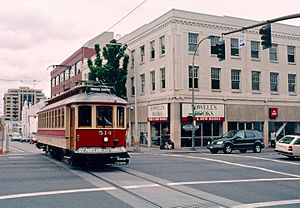
From 2001 to 2005, the Portland Vintage Trolley also ran on a second route. This was the Portland Streetcar line. It went from Northwest Portland to Portland State University (PSU). This service ran on Saturdays and Sundays all year. Two of the four streetcars (513 and 514) were moved to the City of Portland for this new line. The other two cars stayed with TriMet for the original route.
Car 514 was moved to the new line in January 2001. It was used for early test trips because the new modern streetcars weren't ready yet. It was decided that the replica vintage cars needed some changes. They needed outside mirrors and turn signals. The original 1903 cars didn't have these, and they weren't needed on the MAX line. But on the new streetcar line, they would share roads with other traffic. These changes were made to both cars. Car 513 moved to the new line in September 2001.
The Portland Streetcar line opened on July 20, 2001. Vintage Trolley service on it started on July 28. One Vintage Trolley car was used at a time, running every hour. It took the place of a regular modern streetcar. It was thought the vintage trolleys might be needed as backup cars. But the modern cars worked well, so the vintage ones were rarely needed for that.
Vintage Trolley service on the Portland Streetcar stopped around November 2005. This was partly due to maintenance problems with the cars. Also, a new extension of the Portland Streetcar line caused issues for the vintage trolleys. This stop became permanent. After November 2005, the Portland Vintage Trolley only ran on its original MAX route. That route was also changed in 2009.
Route Change in 2009
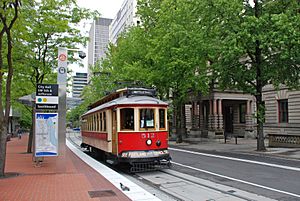
Until mid-2009, the Portland Vintage Trolley used its original route. This route went from the Lloyd District to the Galleria/SW 10th Avenue station downtown. It ran on Sundays from 12 p.m. to 6 p.m., every half-hour, using two cars. The last day on this route was August 23, 2009.
In September 2009, the service changed to a completely different MAX route. Starting September 13, 2009, the Vintage Trolley ran along the Portland Transit Mall. This is on 5th and 6th Avenues in downtown. The route went between Union Station and Portland State University. Now, only one car was used. It ran from 10:30 a.m. to 5:30 p.m. on its operating days. Passengers could get on or off at any MAX station along the 1.5-mile (2.4 km) route. A full round trip took about 30 minutes.
Service Reduction in 2011
In 2011, the service was greatly reduced. This was because of money problems for TriMet. The number of operating days went from about 30–35 per year to just seven. The 2011 schedule included service on Sundays during the busy holiday shopping season. Otherwise, it only ran on three Sundays near Memorial Day, Independence Day, and Labor Day. The route, how often it ran, and hours stayed the same on operating days. This schedule continued in the following years. Even after TriMet stopped its "Free Rail Zone" downtown, rides on the Vintage Trolley remained free.
When the Service Ended
In early 2013, it was announced that two of the four replica streetcars, 513 and 514, would be moved. They went to the Willamette Shore Trolley line. They were meant to replace an old historic streetcar there that had broken down. Car 514 moved in March 2013, and car 513 moved in September 2014. These two cars had not been used since the Vintage Trolley stopped running on the Portland Streetcar line in 2005. All Vintage Trolley service on the MAX system since 2001 had used cars 511 and 512.
On December 6, 2013, TriMet said it planned to sell the last two cars (511 and 512). They would be sold to a group in St. Louis, Missouri. This group was planning to build a heritage streetcar line there, called the Delmar Loop Trolley. TriMet's board approved the sale on December 11. The last two scheduled days for Vintage Trolley service were December 15 and December 22, 2013.
TriMet expected the trolleys to move to St. Louis in mid-2014. But in April 2014, TriMet announced new dates. The cars would move in August 2014. They also said the Vintage Trolley service would run on two more dates in 2014: May 25 and July 6. July 6 was set as the final day of service. The service ran for the last time on July 6, 2014. Cars 511 and 512 left Portland for St. Louis on September 9, 2014.
The Trolley Cars
The four streetcars were built by the Gomaco Trolley Company in Iowa. They were made in 1991 and early 1992. They were designed to look as much as possible like the streetcars that the J. G. Brill Company made for Portland in 1904. Those original ten cars were numbered 501–510. They were used until 1950, when Portland's last city streetcar lines closed.
Even though Brill cars 501–510 weren't only on the Council Crest route, they ran all the service there. So, Portlanders called them the "Council Crest cars." Two of the original Council Crest streetcars, 503 and 506, are still kept at a museum in Brooks, Oregon. Gomaco was able to use these old cars as models for the new replicas. The first replica trolley, car 511, arrived on August 16, 1991. The last one, car 512, arrived on April 23, 1992.
The four cars built by Gomaco in 1991–92 had the same red-and-cream colors as the original 1904 cars. They also had many of the old features. These included padded rattan seats with reversible backrests. They had carved oak interiors, brass handrails, and pull-down window shades. Their doors could only be opened and closed by hand. The new cars were numbered 511–514. This continued the numbering of the older cars as a tribute to them.
On the front of the replica Vintage Trolleys, a slogan was painted. It said, See Portland from Council Crest. This slogan was also on the old trolleys. It referred to the great views of the city from the top of Council Crest. The old trolleys had all-wood bodies. But the replicas have steel frames hidden by wood. This makes them safer and last longer. They also had a more modern way to get power from the overhead wires. This was a mix of a pantograph (like MAX uses) and a bow collector. The city's original trolleys used trolley poles.



